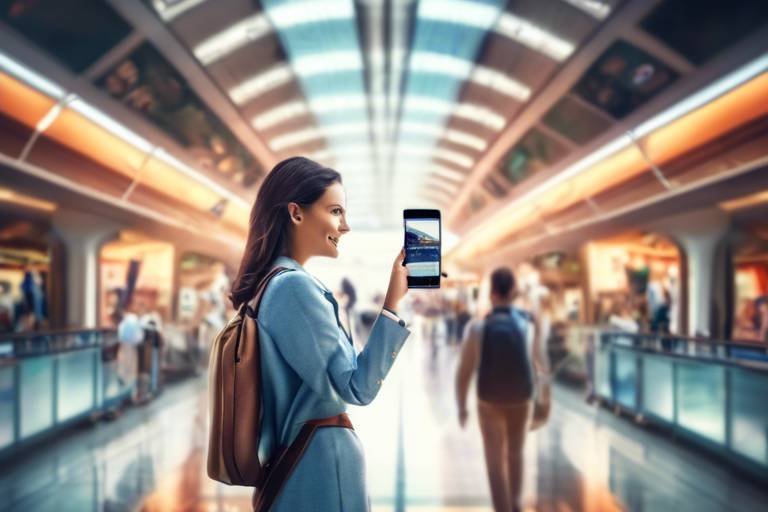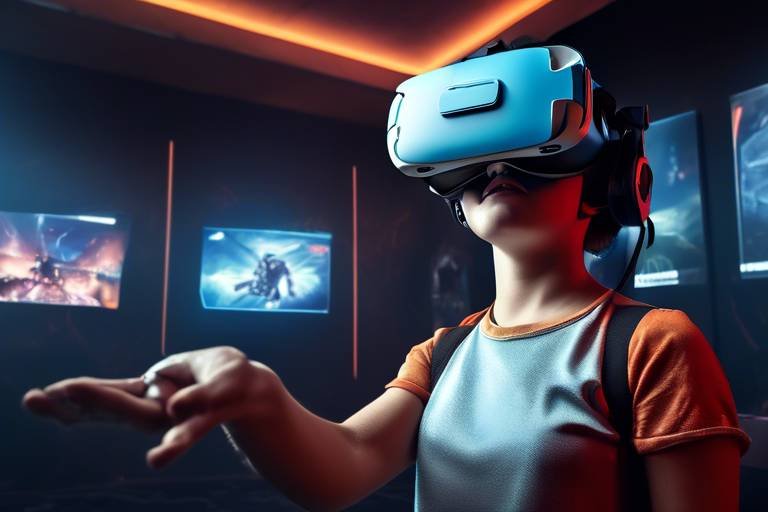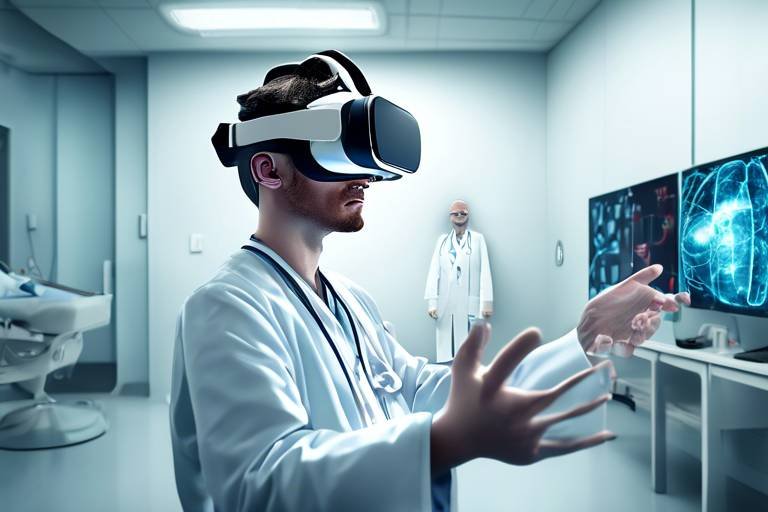Augmented Reality in Advertising: A New Wave
Augmented reality (AR) is not just a buzzword anymore; it's a powerful tool that is reshaping the advertising landscape. Imagine walking through a store and seeing virtual products come to life right in front of your eyes! This innovative technology blends the digital world with our physical reality, creating a dynamic interaction that captivates consumers like never before. With AR, brands are no longer limited to static images or videos; they can craft immersive experiences that engage customers on a deeper level.
The transformative potential of AR in advertising lies in its ability to enhance consumer engagement and elevate brand experiences. As we delve into this exciting realm, we’ll explore how AR is revolutionizing the way brands connect with their audiences. From interactive ads that allow users to try before they buy to personalized experiences that cater to individual tastes, the possibilities are endless. It's like stepping into a new dimension of marketing where imagination meets reality, and the results can be nothing short of astonishing.
As AR technology continues to advance, it opens up a world of opportunities for advertisers to create memorable campaigns that resonate with consumers. Think of it as a game-changer—a new wave that not only captures attention but also drives engagement and loyalty. In this article, we will uncover the rise of augmented reality, its benefits, the challenges brands face in implementation, and what the future holds for this exciting technology in the advertising sphere.

The Rise of Augmented Reality
Augmented reality (AR) has taken the world by storm, and its rise in popularity can be attributed to several key technological advancements. Imagine walking down the street and seeing digital information layered over the physical world—this isn't science fiction; it's the power of AR at work. With the advent of powerful smartphones, sophisticated software, and advanced sensors, AR has seamlessly integrated into our daily lives, transforming the way we interact with brands and products.
One of the most significant milestones in the rise of AR was the development of mobile applications that utilize the camera and sensors of smartphones. These apps allow users to experience AR in a way that was unimaginable just a decade ago. For instance, applications like Pokémon GO have shown how AR can create engaging experiences that blend the digital and physical worlds. It's not just about fun and games; businesses are now leveraging this technology to create immersive advertising experiences that capture the consumer's attention.
Moreover, advancements in computer vision and machine learning have played a crucial role in enhancing the capabilities of AR. These technologies enable AR systems to recognize and interpret the physical environment, allowing for more interactive and personalized experiences. For example, furniture retailers are using AR to let customers visualize how a piece of furniture would look in their own home before making a purchase. This not only enhances the shopping experience but also reduces the likelihood of returns, benefiting both consumers and retailers alike.
As AR continues to evolve, its applications in advertising are becoming more sophisticated. Brands are now able to create experiences that not only showcase their products but also tell compelling stories that resonate with consumers. The integration of AR into advertising strategies has become a game changer, allowing brands to stand out in an overcrowded marketplace. With the potential to enhance consumer engagement, AR is not just a passing trend; it represents a new wave of advertising that is here to stay.
In summary, the rise of augmented reality is a fascinating phenomenon driven by technological advancements. As more brands recognize the potential of AR, we can expect to see even more innovative applications that push the boundaries of consumer engagement. The future of advertising is bright, and AR is leading the charge.
- What is augmented reality? Augmented reality is a technology that overlays digital information, such as images and sounds, onto the real world, enhancing the user's perception of their environment.
- How is AR used in advertising? AR is used in advertising to create immersive experiences that engage consumers, allowing them to interact with products in a virtual space before making a purchase.
- What are the benefits of using AR in marketing? Some benefits include increased consumer engagement, enhanced brand awareness, and the ability to personalize experiences for individual users.
- What challenges do brands face when implementing AR? Brands may encounter technical limitations, high costs, and the need for user education when integrating AR into their advertising strategies.

Benefits of AR in Advertising
Augmented Reality (AR) is not just a buzzword; it’s a game-changer in the advertising world. Imagine walking down the street and seeing a virtual billboard that interacts with you, or trying on clothes without stepping into a fitting room. This is the magic of AR in advertising, and the benefits are as exciting as the technology itself. One of the most significant advantages of AR is its ability to create immersive experiences that resonate with consumers on a deeper level. Unlike traditional ads that often feel intrusive, AR invites users to engage actively, making them part of the narrative. This shift from passive to active participation is crucial in today’s fast-paced digital landscape.
Another key benefit that AR brings to the table is increased engagement. Studies have shown that AR experiences can boost engagement rates significantly compared to conventional advertising methods. When consumers can interact with a product in a virtual space, their interest piques, and they are more likely to remember the brand. For instance, a car manufacturer might allow potential buyers to visualize a new model in their driveway through an AR app, creating a personal connection that traditional ads simply can't achieve.
Moreover, AR offers personalization opportunities that are hard to ignore. Brands can tailor AR content to individual preferences, making the experience unique for each user. For example, a cosmetics brand could develop an AR feature that allows users to try on different makeup looks in real-time, providing a customized shopping experience that enhances customer satisfaction. This level of personalization fosters deeper connections between consumers and brands, leading to increased loyalty and repeat purchases.
Additionally, AR can significantly enhance brand awareness. When consumers have memorable interactions with a brand through AR, they are more likely to share their experiences on social media and with friends. This organic word-of-mouth marketing can lead to a broader reach and greater visibility. To illustrate this, consider a campaign where a beverage company uses AR to create a virtual treasure hunt. Participants share their experiences online, generating buzz and drawing in new customers who want to join the fun.
In summary, the benefits of AR in advertising are multifaceted, ranging from enhanced engagement and interactive experiences to personalization and increased brand awareness. As brands continue to explore the potential of AR, the possibilities for creating impactful marketing campaigns are virtually limitless. The integration of AR technology not only captivates consumers but also transforms the way brands communicate their messages, making advertising more effective and enjoyable.
- What is Augmented Reality in advertising?
Augmented Reality in advertising refers to the use of AR technology to enhance brand experiences by overlaying digital information onto the real world, allowing consumers to interact with products in innovative ways.
- How does AR increase consumer engagement?
AR increases consumer engagement by allowing users to actively participate in brand narratives, creating memorable and interactive experiences that traditional advertising cannot provide.
- Can AR be personalized for individual users?
Yes, AR can be tailored to individual preferences, allowing brands to create unique experiences that resonate with consumers and enhance their satisfaction.
- What are some examples of successful AR advertising campaigns?
Successful AR campaigns include IKEA's app that allows users to visualize furniture in their homes and Snapchat filters that let users try on products virtually.

Increased Engagement
In today's fast-paced digital landscape, capturing consumer attention can feel like trying to catch smoke with your bare hands. Traditional advertising methods often blend into the background noise, making it challenging for brands to stand out. This is where augmented reality (AR) steps in like a superhero, ready to transform the way consumers interact with brands. AR's immersive and interactive nature allows brands to create experiences that not only grab attention but also keep consumers engaged for longer periods.
Imagine walking through a store and pointing your smartphone at a product. Suddenly, your screen comes alive with a 3D model showcasing the product's features, benefits, and even customer reviews. This is the magic of AR—turning a mundane shopping experience into an exciting adventure. According to recent studies, campaigns that incorporate AR can lead to a whopping 70% increase in engagement compared to traditional advertising methods. This statistic is not just a number; it reflects a fundamental shift in how consumers consume content.
Moreover, AR encourages active participation from consumers. Rather than passively viewing an advertisement, they become part of the story. For instance, brands like IKEA have launched applications that allow users to visualize how furniture would look in their own homes through AR technology. This not only enhances the shopping experience but also significantly increases the likelihood of a purchase. By engaging consumers in this manner, brands can foster a deeper emotional connection, making them more likely to remember the brand and its message.
To further illustrate the impact of AR on engagement, consider the following points:
- Interactivity: AR allows consumers to interact with products in a way that static ads simply can't match.
- Memorable Experiences: The novelty of AR creates memorable experiences that resonate with users long after the interaction.
- Social Sharing: Engaging AR experiences are more likely to be shared on social media, amplifying brand reach.
As we move forward, the question arises: how can brands effectively leverage AR to enhance engagement? The key lies in creativity and understanding the target audience. Brands must think outside the box and consider what would genuinely excite and engage their consumers. Whether it’s gamifying a shopping experience or creating educational content that users can interact with, the possibilities are endless.
In conclusion, the integration of AR into advertising strategies is not just a trend; it's a revolutionary approach to engaging consumers. By creating interactive and immersive experiences, brands can significantly increase engagement rates, foster brand loyalty, and ultimately drive sales. As AR technology continues to evolve, those who embrace it will undoubtedly find themselves at the forefront of the advertising landscape.
- What is augmented reality in advertising? Augmented reality in advertising is a technology that overlays digital information, such as images or animations, onto the real world, enhancing the consumer's experience with interactive content.
- How does AR increase consumer engagement? AR increases engagement by providing immersive experiences that allow consumers to interact with products in a dynamic way, making the advertising experience more memorable and enjoyable.
- Can AR be used in all types of advertising? While AR can be applied in various advertising formats, its effectiveness often depends on the product and the target audience. Brands should tailor their AR experiences to fit their specific marketing goals.

Interactive Experiences
In today's fast-paced digital landscape, consumers crave experiences that are not only memorable but also engaging. This is where interactive augmented reality (AR) comes into play, transforming the way brands communicate with their audiences. Imagine walking through a store and pointing your phone at a product, only to see it come to life with 3D animations, videos, or even games. This is the magic of AR, and it offers brands a unique opportunity to create immersive experiences that resonate deeply with consumers.
One of the most remarkable aspects of interactive AR is its ability to foster active participation. Unlike traditional advertisements that often passively consume attention, AR invites users to engage directly with the content. For instance, a cosmetic brand might allow customers to "try on" makeup virtually through their smartphone camera, providing a fun and interactive way to explore products. This not only enhances the shopping experience but also encourages users to share their AR encounters on social media, amplifying brand reach.
Moreover, successful interactive campaigns have demonstrated that consumers are more likely to remember and connect with brands that offer these engaging experiences. A prime example is the popular AR campaign by IKEA, which allows users to visualize how furniture would look in their own homes before making a purchase. This kind of personalization and interactivity not only boosts consumer confidence but also helps in reducing return rates, as customers feel more satisfied with their choices.
To illustrate the impact of interactive AR, consider the following table showcasing some successful AR campaigns:
| Brand | Campaign Name | Description | Impact |
|---|---|---|---|
| IKEA | IKEA Place | Allows users to visualize furniture in their homes using AR. | Increased sales and reduced return rates. |
| Pepsi | Pepsi Max AR Bus Shelter | Transforms a bus shelter into an AR experience with surprising visuals. | Went viral, significantly boosting brand awareness. |
| Snapchat | Snap Lenses | Interactive filters that let users modify their appearance. | Enhanced user engagement and brand interaction. |
As we can see, the potential of interactive AR is vast. It not only enhances the consumer experience but also builds a deeper connection between the brand and its audience. By creating interactive narratives, brands can tell their stories in a way that feels personal and relevant, making consumers feel like they are part of something bigger. This level of engagement is invaluable in today's competitive market, where standing out is more crucial than ever.
In conclusion, interactive experiences powered by augmented reality are reshaping the advertising landscape. Brands that embrace this technology not only capture attention but also cultivate loyalty and advocacy among their consumers. As we continue to explore the possibilities of AR, it’s clear that the future of advertising is not just about selling products but about creating unforgettable experiences.
- What is augmented reality in advertising? Augmented reality in advertising refers to the use of AR technology to create interactive and immersive experiences that enhance consumer engagement with brands.
- How does AR increase consumer engagement? AR increases engagement by allowing consumers to interact with products in a fun and meaningful way, making the shopping experience more enjoyable and memorable.
- What are some examples of successful AR campaigns? Successful AR campaigns include IKEA's Place app, Pepsi's AR Bus Shelter, and Snapchat's Snap Lenses, all of which have effectively engaged consumers.
- Are there challenges to implementing AR in advertising? Yes, challenges include technical limitations, high costs, and the need for user-friendly experiences to ensure broad adoption.

Personalization Opportunities
In today's fast-paced digital world, consumers are bombarded with an overwhelming amount of advertisements vying for their attention. This is where augmented reality (AR) steps in with a game-changing solution: personalization. Imagine walking into a store and being greeted by a virtual assistant that knows your name and preferences. Sounds futuristic, right? Well, AR technology is making this a reality, allowing brands to tailor experiences uniquely to each consumer. By leveraging data analytics and user behavior, brands can create AR experiences that resonate on a personal level, making customers feel valued and understood.
Personalization through AR can take many forms, from customized product recommendations to interactive experiences that adapt based on user interaction. For example, a beauty brand might use AR to allow customers to virtually try on makeup shades that complement their skin tone. This not only enhances the shopping experience but also increases the likelihood of purchase, as customers can see how a product will look on them before making a decision. The ability to visualize products in a personalized manner can significantly reduce the hesitation often felt during online shopping.
Moreover, AR can facilitate deeper connections between brands and consumers. When a brand uses AR to deliver personalized content, it creates a sense of exclusivity and engagement. For instance, a clothing retailer might offer an AR experience that shows customers how to style an outfit based on their previous purchases or preferences. This not only enhances user satisfaction but also fosters brand loyalty, as customers are more likely to return to a brand that understands their individual tastes.
To illustrate the potential of AR in personalization, consider the following table showcasing various AR applications and their personalized benefits:
| AR Application | Personalization Benefit |
|---|---|
| Virtual Try-Ons | Allows customers to see how products look on them in real-time, enhancing decision-making. |
| Customized Promotions | Offers tailored discounts or product suggestions based on user history and preferences. |
| Interactive Storytelling | Engages users with narratives that adapt based on their choices, creating a unique experience for each user. |
As brands continue to explore the vast potential of AR, the opportunities for personalization are limitless. By integrating AR technology into their marketing strategies, companies can create memorable, engaging experiences that not only attract attention but also foster long-lasting relationships with their customers. In a world where consumers crave authenticity and connection, AR personalization is not just a trend; it’s the future of advertising.
- What is augmented reality in advertising?
Augmented reality in advertising refers to the use of AR technology to create interactive and immersive experiences that enhance consumer engagement with products and brands. - How does AR improve personalization in marketing?
AR improves personalization by allowing brands to tailor experiences and content based on individual consumer preferences, behaviors, and past interactions. - What are some examples of AR in advertising?
Examples include virtual try-ons for clothing and makeup, interactive product demonstrations, and personalized promotions delivered through AR applications. - Are there any challenges to implementing AR in advertising?
Yes, challenges include technical limitations, cost considerations, and the need for user-friendly interfaces to ensure a seamless experience.

Enhanced Brand Awareness
In today's fast-paced digital landscape, where consumers are bombarded with countless advertisements daily, standing out from the crowd is more crucial than ever. This is where augmented reality (AR) steps in as a game changer. AR not only captivates users but also creates a lasting impression that traditional advertising methods often fail to achieve. Imagine walking down the street and seeing a virtual billboard that not only displays a product but allows you to interact with it in real-time. This immersive experience can significantly enhance brand awareness by making the brand memorable and engaging.
One of the most compelling aspects of AR is its ability to create memorable experiences. When consumers engage with a brand through AR, they are not just passive observers; they become active participants. This level of engagement can lead to a deeper emotional connection with the brand. For instance, a beauty brand might allow users to virtually try on makeup products using AR technology. This not only boosts awareness but also encourages users to share their experiences on social media, further amplifying the brand's reach.
Moreover, AR experiences can be tailored to resonate with specific audiences. Brands can utilize data analytics to understand consumer preferences and create personalized AR campaigns that speak directly to their target demographic. This level of personalization can significantly increase brand recall, as consumers are more likely to remember brands that cater to their individual tastes and interests. For example, a furniture retailer could offer an AR app that lets customers visualize how a piece of furniture would look in their own home, making the shopping experience both interactive and relevant.
To illustrate the impact of AR on brand awareness, consider the following table that highlights key statistics from recent AR advertising campaigns:
| Brand | AR Campaign | Engagement Rate | Brand Recall Increase |
|---|---|---|---|
| Pepsi | Pepsi Max AR Bus Stop | 75% | 60% |
| IKEA | IKEA Place | 80% | 70% |
| Sephora | Virtual Artist | 85% | 65% |
As you can see, brands that have embraced AR technology have seen remarkable increases in both engagement rates and brand recall. This is no coincidence; the unique nature of AR allows brands to create experiences that are not just seen but felt. Consumers are more likely to remember a brand that has provided them with an enjoyable and interactive experience, leading to increased loyalty and repeat purchases.
In conclusion, the integration of augmented reality into advertising strategies offers brands an innovative way to enhance their visibility and recognition. By creating immersive and interactive experiences, brands can not only capture consumer attention but also foster a deeper emotional connection that translates into long-term loyalty. As AR technology continues to evolve, its potential to revolutionize brand awareness will only grow, making it an essential tool for marketers looking to stay ahead in a competitive landscape.
- What is augmented reality? Augmented reality is a technology that overlays digital information, such as images or sounds, onto the real world, enhancing the user's perception of their environment.
- How does AR improve brand awareness? AR creates immersive experiences that engage consumers, making brands more memorable and increasing the likelihood of sharing experiences on social media.
- What industries can benefit from AR advertising? Industries such as retail, real estate, entertainment, and education can significantly benefit from AR advertising by enhancing consumer engagement and interactions.
- Are there any challenges to implementing AR in advertising? Yes, challenges include technical limitations, costs, and the need for consumer education on how to use AR applications effectively.

Challenges of Implementing AR
While the potential of Augmented Reality (AR) in advertising is vast, it doesn't come without its own set of challenges. Brands eager to tap into this innovative technology often encounter a variety of obstacles that can hinder their efforts. Understanding these challenges is crucial for any business looking to integrate AR into their marketing strategy.
One of the most significant hurdles is the technical limitations associated with AR. These can range from issues with compatibility across different devices to accessibility concerns for users who may not have the latest smartphones or AR-enabled devices. Imagine crafting a stunning AR experience only to find out that a significant portion of your audience cannot access it! To ensure a seamless user experience, brands must invest in thorough testing and possibly even develop multiple versions of their AR applications to cater to different devices.
Cost considerations also play a critical role in the implementation of AR advertising. Developing high-quality AR content can be expensive, requiring specialized skills and technology that may not be readily available in-house. For many brands, especially smaller ones, the financial implications can be daunting. It's essential for businesses to weigh the potential return on investment (ROI) against the costs involved. To optimize budget allocation, brands should consider starting with smaller pilot projects that allow them to gauge effectiveness before committing to larger-scale AR campaigns.
Moreover, there's the challenge of consumer adoption. While AR is gaining traction, not all consumers are familiar with how to use it effectively. Brands must invest not only in creating engaging AR content but also in educating their audience on how to interact with it. This could involve creating tutorial videos, engaging social media campaigns, or even in-store demonstrations to ensure that consumers feel comfortable and excited about using AR experiences.
Lastly, there are concerns surrounding data privacy and security. With the rise of AR, brands collect more data than ever before. Consumers are becoming increasingly aware of how their data is used, and any misstep in handling this information can lead to a loss of trust. Brands must prioritize transparency and security to build a solid relationship with their audience. Addressing these challenges head-on is essential for brands looking to harness the full potential of AR in their advertising strategies.
- What are the main challenges of implementing AR in advertising?
Technical limitations, cost considerations, consumer adoption, and data privacy concerns are some of the primary challenges brands face. - How can brands overcome technical limitations?
Brands can invest in thorough testing and potentially develop multiple versions of AR applications to ensure compatibility across devices. - Is AR advertising expensive?
Yes, developing high-quality AR content can be costly, but starting with smaller pilot projects can help brands gauge effectiveness before larger investments. - How can brands educate consumers on using AR?
Brands can create tutorial videos, engaging social media campaigns, and in-store demonstrations to help consumers feel comfortable using AR experiences. - What should brands do to ensure data privacy?
Brands must prioritize transparency and security in handling consumer data to build trust and maintain customer relationships.

Technical Limitations
While augmented reality (AR) presents a thrilling frontier for advertising, it is not without its . As brands race to adopt this cutting-edge technology, they often encounter hurdles that can impede the seamless integration of AR into their marketing strategies. One major concern is compatibility. Not all devices support AR applications, which can limit the audience reach. For instance, older smartphones may not have the processing power or camera capabilities to run AR apps effectively, leading to a fragmented user experience.
Additionally, accessibility poses a significant challenge. Many consumers may not be familiar with how to engage with AR content, which can lead to frustration rather than excitement. Imagine walking into a store, ready to experience a brand's innovative AR feature, only to find that you don't know how to activate it. This scenario is all too common and can result in lost opportunities for brands to connect with potential customers.
Another technical limitation is related to the internet connectivity required for many AR applications. High-quality AR experiences often rely on real-time data streaming, which can be problematic in areas with poor network coverage. This can lead to lagging visuals or even complete application failures, detracting from the immersive experience that AR promises to deliver.
Finally, there's the issue of development costs. Creating high-quality AR content requires specialized skills and tools, which can be a financial burden for smaller brands. The investment needed to develop AR experiences can be significant, and without a clear return on investment, many businesses may hesitate to dive into this technology.
To summarize, while AR holds remarkable potential for advertising, brands must navigate several technical limitations to fully harness its power. Addressing compatibility, accessibility, connectivity, and development costs is essential for creating a successful AR strategy that resonates with consumers.
- What devices are compatible with AR applications?
Most modern smartphones and tablets support AR applications, but older models may not be compatible. It's essential to check the specific requirements of the AR app you wish to use.
- How can brands overcome technical limitations in AR?
Brands can invest in user education, ensure their content is optimized for multiple devices, and consider offline capabilities to enhance accessibility.
- Is AR advertising cost-effective?
While initial development costs can be high, successful AR campaigns often lead to increased engagement and brand loyalty, which can provide a strong return on investment over time.

Cost Considerations
When it comes to integrating augmented reality (AR) into advertising, one of the most pressing issues brands face is the cost. While the allure of AR is undeniable, the financial implications can be daunting. Implementing AR technology often requires significant investment in both hardware and software, as well as the expertise to create engaging content. Brands must weigh these costs against the potential returns on investment (ROI) that AR can deliver.
To put things into perspective, consider the various elements that contribute to the overall cost of an AR campaign. These can include:
- Development Costs: Creating AR applications can be complex and time-consuming, requiring skilled developers and designers. The more sophisticated the AR experience, the higher the development costs.
- Hardware Requirements: Some AR experiences may necessitate specific hardware, such as AR glasses or mobile devices with advanced capabilities, which can add to the expense.
- Marketing and Distribution: Once the AR experience is developed, brands must also invest in marketing it effectively to ensure it reaches the intended audience.
It's crucial for brands to conduct a thorough cost-benefit analysis before diving into AR advertising. This analysis should consider not only the immediate costs but also the long-term benefits, such as increased consumer engagement and enhanced brand loyalty. For example, a well-executed AR campaign can lead to a significant boost in brand visibility, making the initial investment worthwhile.
Moreover, brands can explore various strategies to optimize their budget allocation for AR advertising. These strategies might include:
- Collaborations: Partnering with AR specialists or agencies can help brands access expertise without bearing the full cost of development.
- Phased Implementation: Instead of launching a full-scale AR campaign, brands can start with smaller pilot projects to test the waters and assess their effectiveness.
- Utilizing Existing Platforms: Leveraging existing AR platforms or tools can reduce development costs and expedite the process.
In conclusion, while the cost considerations of AR in advertising may seem daunting, they are not insurmountable. By strategically planning and exploring innovative solutions, brands can harness the power of AR without breaking the bank. The key lies in understanding the potential for return on investment and making informed decisions that align with their overall marketing goals.
Q1: Is AR advertising too expensive for small businesses?
A1: While AR advertising can be costly, small businesses can start with smaller projects or collaborate with AR specialists to reduce expenses. Many platforms offer affordable AR solutions tailored for smaller budgets.
Q2: What are the potential returns on investment for AR advertising?
A2: AR advertising can lead to increased engagement, brand awareness, and customer loyalty. Many brands report higher conversion rates and improved customer experiences through AR campaigns, making the investment worthwhile.
Q3: Are there any free tools available for creating AR content?
A3: Yes, there are several free or low-cost tools available that can help brands create basic AR experiences. These tools often come with templates and user-friendly interfaces, making it easier for brands to get started.

The Future of AR in Advertising
As we gaze into the crystal ball of technological advancements, the future of Augmented Reality (AR) in advertising appears not just bright but also profoundly transformative. Imagine walking through a bustling city, and instead of just seeing static billboards, you encounter vibrant, interactive advertisements that leap off the surface and engage your senses. This is not a distant dream; it is the direction in which AR is heading. With the rapid evolution of technology, we can expect to see even more innovative applications of AR that will redefine how brands connect with consumers.
One of the most exciting prospects for AR in advertising is the integration of artificial intelligence (AI) to create personalized experiences. By analyzing consumer data, brands can tailor AR content in real-time, providing users with highly relevant advertisements that resonate with their preferences and behaviors. Picture this: you’re in a store, and as you point your smartphone at a product, an AR overlay appears, showcasing customer reviews, product details, and even discounts, all personalized just for you. This level of customization not only enhances consumer satisfaction but also significantly boosts conversion rates.
Moreover, the rise of 5G technology is set to revolutionize AR advertising. With faster internet speeds and lower latency, the barriers that currently limit AR experiences will diminish. Brands will be able to deploy more complex and data-rich AR applications without the fear of lag or connectivity issues. This means that interactive experiences can be more fluid and engaging, leading to increased consumer retention and brand loyalty. Imagine attending a live event and using AR to interact with your favorite brands in real-time, all facilitated by the lightning-fast connectivity of 5G.
However, as we embrace this future, it’s crucial to consider the ethical implications of AR advertising. As brands gather more data to create personalized experiences, they must also prioritize consumer privacy and data security. Transparency in how data is collected and used will be paramount in building trust with consumers. Brands that can navigate these challenges effectively will not only enhance their reputation but also create long-term relationships with their audience.
In addition to personalization and ethical considerations, we can expect AR to become a more ubiquitous part of our daily lives. With the proliferation of smart glasses and wearable technology, AR will soon be accessible at a glance, allowing consumers to engage with advertisements seamlessly as they go about their day. This shift will require brands to rethink their strategies and consider how their messaging can fit into the fast-paced, on-the-go lifestyle of modern consumers.
To sum it up, the future of AR in advertising is not just about creating flashy visuals; it's about crafting meaningful experiences that resonate with consumers on a deeper level. As technology continues to evolve, the possibilities are endless. Brands that stay ahead of the curve and embrace these changes will undoubtedly find themselves at the forefront of a new wave of advertising innovation.
- What is Augmented Reality in advertising?
Augmented Reality in advertising refers to the integration of digital information with the user's environment in real time, enhancing the consumer's experience with interactive and immersive content. - How can AR improve consumer engagement?
AR captures consumer attention through interactive experiences that encourage participation, leading to higher engagement rates compared to traditional advertising methods. - What are the challenges of implementing AR in advertising?
Some challenges include technical limitations, cost considerations, and the need for a seamless user experience to ensure consumer satisfaction. - What does the future hold for AR in advertising?
The future is promising, with advancements in AI, 5G technology, and smart wearables expected to enhance personalization and accessibility, creating more engaging advertising experiences.
Frequently Asked Questions
- What is Augmented Reality (AR) in advertising?
Augmented Reality (AR) in advertising refers to the use of digital technology to overlay virtual elements onto the real world, enhancing consumer experiences with interactive and immersive content. This innovative approach allows brands to engage customers in a more dynamic and memorable way.
- How does AR increase consumer engagement?
AR increases consumer engagement by providing interactive experiences that capture attention and encourage participation. Unlike traditional ads, AR allows users to interact with products in a virtual space, making the advertising experience more enjoyable and impactful.
- What are some examples of successful AR advertising campaigns?
Some notable examples include IKEA's Place app, which lets users visualize furniture in their homes, and Pepsi's AR bus shelter campaign that created immersive experiences for unsuspecting commuters. These campaigns not only entertained but also fostered deeper connections between consumers and brands.
- Are there any challenges to implementing AR in advertising?
Yes, there are challenges such as technical limitations, including compatibility issues across devices, and high implementation costs. Brands need to carefully plan their AR strategies to ensure a smooth user experience and justify the investment.
- How can brands overcome the cost considerations of AR advertising?
Brands can optimize budget allocation by starting with smaller-scale AR projects, collaborating with AR development companies, and leveraging existing technologies. This approach allows them to test the waters before making larger financial commitments.
- What is the future of AR in advertising?
The future of AR in advertising looks bright, with emerging trends like AI integration, improved hardware, and more personalized experiences on the horizon. As technology evolves, we can expect AR to become an even more integral part of marketing strategies, enhancing brand storytelling and consumer interactions.



















